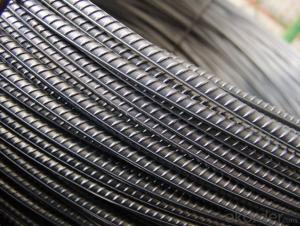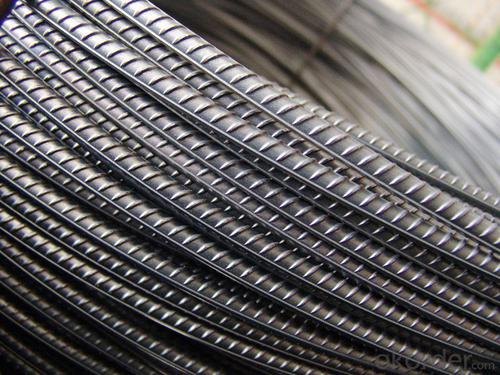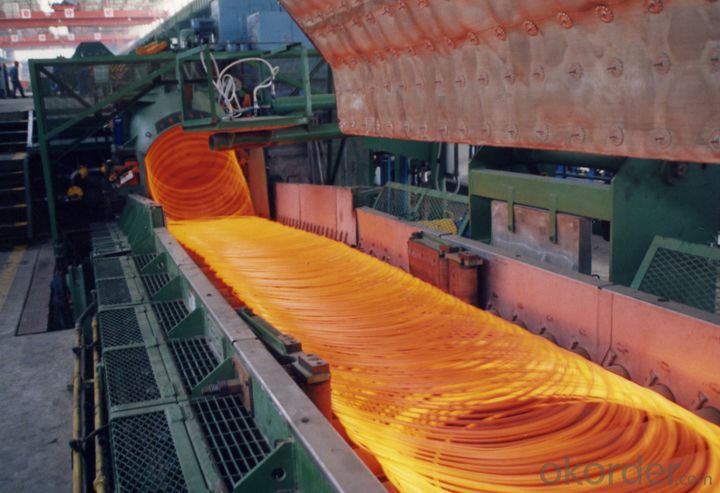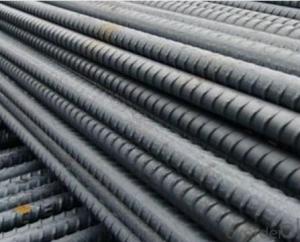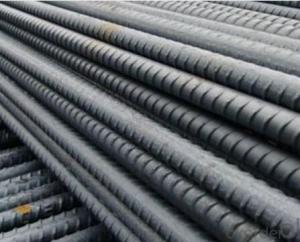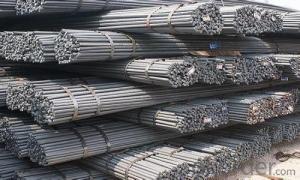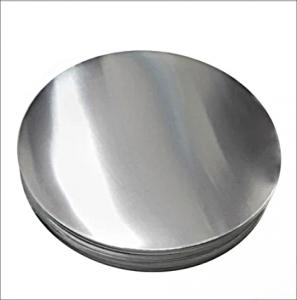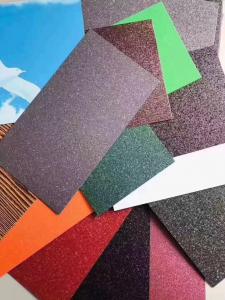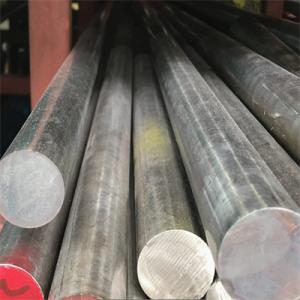Rebar 3 Diameter Hot Rolled Steel Deformed Bar in Coils
- Loading Port:
- China Main Port
- Payment Terms:
- TT or LC
- Min Order Qty:
- 100 m.t.
- Supply Capability:
- 5000 m.t./month
OKorder Service Pledge
OKorder Financial Service
You Might Also Like
Product Description:
OKorder is offering Hot Rolled Steel Deformed Bar in Coils at great prices with worldwide shipping. Our supplier is a world-class manufacturer of steel, with our products utilized the world over. OKorder annually supplies products to African, South American and Asian markets. We provide quotations within 24 hours of receiving an inquiry and guarantee competitive prices.
Product Applications:
Hot Rolled Steel Deformed Bar in Coils are ideal for structural applications and are widely used in forest region, Mines, factories and construction sites laid of the place such as temporary transport line and light motorcycles with line..
Product Advantages:
OKorder's Hot Rolled Steel Deformed Bar in Coils are durable, strong, and wide variety of sizes.
Main Product Features:
· Premium quality
· Prompt delivery & seaworthy packing (30 days after receiving deposit)
· Can be recycled and reused
· Mill test certification
· Professional Service
· Competitive pricing
Product Specifications:
Manufacture: Hot rolled
Grade: HRB335,HRB400,HRB500
Certificates: ISO, SGS, BV, CIQ
Diameter:6mm-10mm
Packing: products are packed in coils and shipped by break bulk or containers
Grade | Technical data of the original chemical composition (%) | |||||||
C | Mn | Si | S | P | B | |||
HRB335 | ≤0.25 | ≤1.60 | ≤0.80 | ≤0.045 | ≤0.045 | >0.0008 | ||
Physics capability | ||||||||
Yield Strength(N/cm2) | Tensile Strength(N/cm2) | Elongation (%) | ||||||
≥335 | ≥490 | ≥16 | ||||||
FAQ:
Q1: Why buy Materials & Equipment from OKorder.com?
A1: All products offered byOKorder.com are carefully selected from China's most reliable manufacturing enterprises. Through its ISO certifications, OKorder.com adheres to the highest standards and a commitment to supply chain safety and customer satisfaction.
Q2: How do we guarantee the quality of our products?
A2: We have established an advanced quality management system which conducts strict quality tests at every step, from raw materials to the final product. At the same time, we provide extensive follow-up service assurances as required.
Q3: How soon can we receive the product after purchase?
A3: Within three days of placing an order, we will arrange production. The normal sizes with the normal grade can be produced within one month. The specific shipping date is dependent upon international and government factors, the delivery to international main port about 45-60days.
Images:
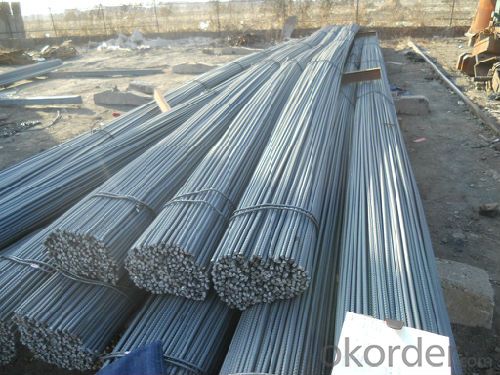
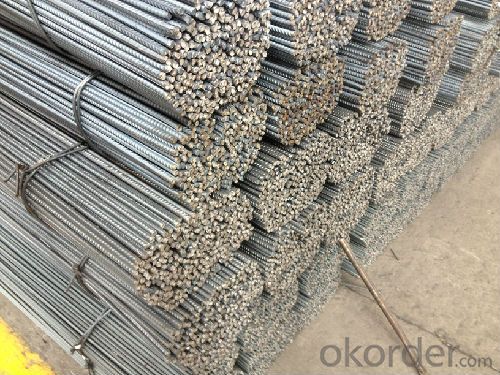
- Q:How are steel rebars protected against accidental damage during construction?
- Steel rebars are protected against accidental damage during construction through various measures. One common method is to cover them with plastic caps or sleeves that provide a physical barrier and prevent them from being hit or damaged by construction equipment or debris. Additionally, rebars are often placed in designated areas and marked with caution tape to make workers aware of their presence and avoid accidental damage. Regular inspections are carried out to ensure rebars are not exposed or damaged, and if necessary, temporary barriers or covers are used to protect them until construction work is completed.
- Q:What is the effect of aging on the properties of steel rebars?
- The effect of aging on the properties of steel rebars is generally negative. Over time, steel rebars may experience gradual deterioration due to factors such as corrosion, fatigue, and stress. This can lead to a reduction in their structural integrity and load-bearing capacity. Aging can also cause an increase in brittleness, making rebars more prone to fractures and failures. Therefore, regular inspections, maintenance, and potentially replacement of aged rebars are crucial to ensure the safety and longevity of structures.
- Q:Can steel rebars be used in the construction of underground parking facilities?
- Yes, steel rebars can be used in the construction of underground parking facilities. Steel rebars provide reinforcement to the concrete structure, enhancing its strength and durability. They are commonly used in the construction of foundations, walls, and slabs, making them suitable for underground parking facilities where robust structural support is required.
- Q:How do steel rebars affect the shrinkage and creep behavior of concrete?
- The shrinkage and creep behavior of concrete are significantly impacted by steel rebars. Shrinkage occurs when concrete contracts as it dries and hardens, while creep refers to the long-term deformation of concrete under sustained load. The presence of steel rebars in concrete has two main effects on its overall shrinkage. Firstly, the rebars provide resistance against shrinkage by countering the tensile forces that arise during drying. This resistance limits the volume change of the concrete, minimizing shrinkage. Secondly, the rebars act as a barrier to moisture movement, thus restricting the drying and shrinkage of the concrete. Nevertheless, the addition of steel rebars can also influence the creep behavior of the concrete. Creep is influenced by the material's modulus of elasticity and strength, both of which can be altered by the presence of steel rebars. The high modulus of elasticity and strength of the rebars can lead to higher levels of creep in the concrete, as there can be differential deformation between the concrete and the steel. Furthermore, the bond between the rebars and the concrete also affects the creep behavior. The strength of this bond influences the transfer of stress from the concrete to the rebars, thereby impacting the overall creep behavior of the composite material. In conclusion, steel rebars can reduce concrete shrinkage by providing resistance against drying and limiting moisture movement. However, they can also influence the creep behavior of the concrete due to factors such as modulus of elasticity, strength, and bond strength between the rebars and the concrete. Understanding the interaction between steel rebars and concrete is essential for designing structures that can withstand shrinkage and creep effects.
- Q:Are there any disadvantages or limitations of using steel rebars?
- Yes, there are some disadvantages and limitations of using steel rebars. Firstly, steel rebars are susceptible to corrosion when exposed to moisture and other corrosive elements, which can lead to structural deterioration over time. Additionally, steel rebars are heavy and require skilled labor and heavy machinery for installation, making the construction process more expensive and time-consuming. Furthermore, steel rebars have a high thermal conductivity, which can result in increased heat transfer, making them less suitable for certain applications. Lastly, steel rebars have a high carbon footprint due to the energy-intensive manufacturing process, contributing to environmental concerns.
- Q:Can steel rebars be used in the construction of shopping centers?
- Yes, steel rebars can be used in the construction of shopping centers. Steel rebars are commonly used in reinforced concrete structures, including commercial buildings like shopping centers, as they provide strength, durability, and resistance to structural forces.
- Q:What is the minimum cover required for steel rebars in concrete?
- The minimum cover required for steel rebars in concrete is typically specified by codes and standards, but it is generally recommended to have a minimum cover of 1.5 inches (38 mm) for rebars in normal conditions to ensure proper protection against corrosion and provide adequate fire resistance.
- Q:What is the process of pre-stressing steel rebars?
- The process of pre-stressing steel rebars involves applying a predetermined amount of stress or force to the rebars before they are subjected to loading. This technique is commonly used in the construction industry to improve the structural strength and durability of concrete structures. The process typically starts with the selection of high-strength steel rebars that have good tensile strength properties. These rebars are usually made from carbon steel or alloy steel and come in various sizes and shapes, depending on the specific application. Once the rebars are selected, they are cleaned and coated with a protective layer to prevent corrosion. After that, the rebars are placed into the desired position within the concrete structure, such as beams, columns, or slabs, according to the design specifications. Next, the pre-stressing process begins. There are two primary methods for pre-stressing steel rebars: pre-tensioning and post-tensioning. In pre-tensioning, the rebars are initially tensioned by fixing them to an anchorage point or a strong frame. The opposite end of the rebars is then pulled using hydraulic jacks or mechanical devices, applying a significant amount of force. Once the desired stress is achieved, the rebars are secured in their stressed position by casting concrete around them. After the concrete has hardened, the jacks or devices are released, transferring the stress to the rebars. In post-tensioning, the rebars are first placed into the concrete structure without any initial tension. After the concrete has hardened, a series of ducts or channels are created within the structure, running along the path of the rebars. High-strength steel strands or cables are then inserted through these ducts. The strands are anchored at one end of the structure and tensioned using hydraulic jacks or similar devices. This tensioning process applies a force to the rebars, which is transferred to the concrete, compressing it. Once the desired stress is achieved, the strands are secured and the ducts are filled with grout or mortar to protect them from corrosion. Both pre-tensioning and post-tensioning techniques result in pre-stressed steel rebars that provide several benefits to concrete structures. These include increased load-carrying capacity, improved resistance to cracking and deformation, enhanced durability, and overall better structural performance. The process of pre-stressing steel rebars is a vital aspect of modern construction practices, ensuring the longevity and safety of various types of concrete structures.
- Q:What are the international standards for steel rebars?
- The international standards for steel rebars are defined by the International Organization for Standardization (ISO) and the American Society for Testing and Materials (ASTM). These standards encompass various factors such as the composition, mechanical properties, dimensions, and tolerances of steel rebars, ensuring their quality and performance in construction projects worldwide.
- Q:What are the guidelines for the proper spacing of steel rebars in slabs?
- The guidelines for the proper spacing of steel rebars in slabs are crucial to ensure the structural integrity and strength of the concrete slab. Here are the general guidelines to follow: 1. Rebar Diameter: The diameter of the steel rebar should be determined based on the load and design requirements. Common rebars sizes range from 6mm to 32mm. 2. Spacing: The spacing between rebars is determined by the thickness of the slab and the design specifications. As a general rule, the spacing should not exceed three times the slab thickness. For example, if the slab thickness is 150mm, the maximum spacing between rebars should be 450mm. 3. Edge Distance: The distance between the rebar and the edge of the slab is also crucial. The minimum edge distance should be at least 50mm to prevent cracking and ensure proper load distribution. 4. Clear Cover: The clear cover refers to the distance between the rebar and the surface of the slab. It is essential to provide sufficient clear cover to protect the rebar from corrosion. The clear cover requirements vary depending on the environmental conditions, but commonly range from 20mm to 40mm. 5. Reinforcement Ratio: The reinforcement ratio is the amount of steel reinforcement used per unit area of the slab. This ratio is determined by the load requirements and the design specifications. Typically, the reinforcement ratio ranges from 0.5% to 2%. 6. Lap Splicing: In cases where the length of the rebar is insufficient, lap splicing is required. The lap length should be determined based on the rebar diameter, grade, and design requirements. 7. Placement: The rebars should be placed accurately and securely inside the slab formwork. Proper alignment and placement ensure that the rebars are positioned correctly to resist the anticipated loads. It is important to note that these guidelines are general and may vary depending on the specific project, structural design, and local building codes. It is recommended to consult with a structural engineer or refer to the relevant building codes and standards for precise guidelines specific to your project.
1. Manufacturer Overview |
|
|---|---|
| Location | |
| Year Established | |
| Annual Output Value | |
| Main Markets | |
| Company Certifications | |
2. Manufacturer Certificates |
|
|---|---|
| a) Certification Name | |
| Range | |
| Reference | |
| Validity Period | |
3. Manufacturer Capability |
|
|---|---|
| a)Trade Capacity | |
| Nearest Port | |
| Export Percentage | |
| No.of Employees in Trade Department | |
| Language Spoken: | |
| b)Factory Information | |
| Factory Size: | |
| No. of Production Lines | |
| Contract Manufacturing | |
| Product Price Range | |
Send your message to us
Rebar 3 Diameter Hot Rolled Steel Deformed Bar in Coils
- Loading Port:
- China Main Port
- Payment Terms:
- TT or LC
- Min Order Qty:
- 100 m.t.
- Supply Capability:
- 5000 m.t./month
OKorder Service Pledge
OKorder Financial Service
Similar products
New products
Hot products
Hot Searches
Related keywords
